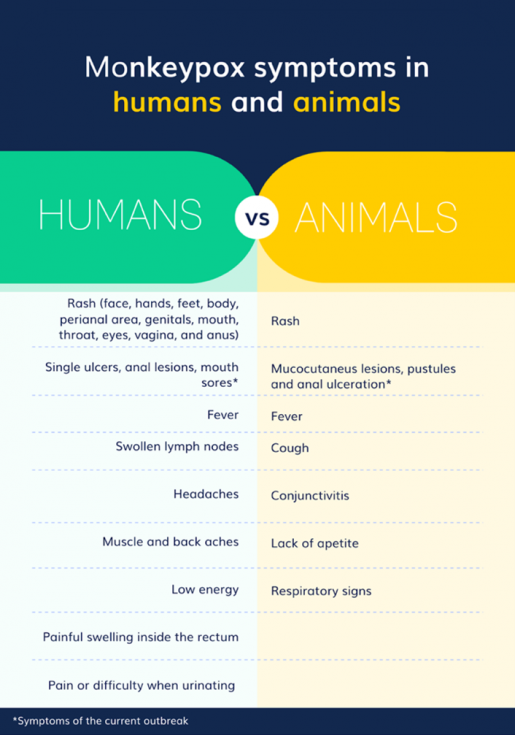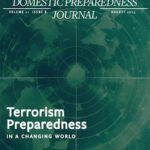- Agriculture & Food Defense, Articles, CBRNE, Critical Infrastructure, Hazmat, Hospitals, Law Enforcement, Public Health, Science & Technology, Transportation
- Deborah Sateler and Mabel de Leo
Declared a public health emergency of international concern by the World Health Organization (WHO), monkeypox has been on the news since early May 2022 due to the high number of cases and its worldwide distribution. The current outbreak varies from the historical situation, in which the virus remained endemic in West or Central Africa with occasional international events. Current data shows particularities of this global outbreak of monkeypox in terms of transmission, symptoms, and population at risk that continues to be studied.
Monkeypox has become a challenging and threatening situation worldwide. On July 23, 2022, the WHO declared monkeypox a Public Health Emergency of International Concern (PHEIC). This status involves the expanded spread of a disease that might require a coordinated international response. The ongoing outbreak accounts for most cases in the African, European, and the Americas regions. Detailed data on the cases is available online.
Overview of the Disease
Human monkeypox (MPX) is a disease caused by the monkeypox virus (MPXV), an orthopox DNA virus with a clinical presentation similar to the virus that causes smallpox. MPXV was first isolated in 1958 in a Danish laboratory from pox lesions during an outbreak among monkeys used for research. It was described in humans for the first time in 1970 in the Democratic Republic of Congo. Since then, outbreaks reported in Africa have been mostly associated with wildlife reservoirs (i.e., where an infectious agent lives and multiplies), which are believed to be rodents.

In 2003, the first outbreak outside of Africa was reported in the United States and linked to the importation of infected pet prairie dogs. After that, there have been a few outbreaks in countries outside of Africa related to travel. However, the current global outbreak has been reported in non-endemic countries without links to travel or imported mammals.
Monkeypox virus can infect a wide range of mammal species, but infection in reptiles, amphibians, or birds is considered unlikely. The Centers for Disease Control and Prevention (CDC) developed a list of susceptible animals that professionals who manipulate or are exposed to animals should consult.
The transmission of MPXV can occur animal-to-human (zoonotic) through direct contact with an infected animal’s skin or mucosal lesions, blood, or bodily fluids. Exposure to contaminated animal products and inadequately cooked meat are considered risk factors. The human-to-human transmission occurs through large respiratory droplets, close or direct contact with respiratory secretions, skin lesions, and contaminated objects. Vertical transmission (via the placenta from mother to fetus) is possible. There is no evidence of sexual transmission through seminal or vaginal fluids. Still, this transmission route is being investigated as the current outbreak has disproportionately affected men who have sex with men and has been associated with anal and genital lesions.
Endemic monkeypox is generally self-limited; this means, it will resolve without treatment. The incubation period ranges from 5 to 21 days, symptoms last from 2 to 4 weeks, and the fatality rate is 3% to 6%. Most people who contract monkeypox have mild symptoms (see Figure 1 for a list of human and animal symptoms). As a result, the treatment is mainly supportive and symptomatic (alleviating symptoms such as pain, fever, pruritus, and hydration). Antivirals such as tecovirimat, brincidofovir, and cidofovir are considered an option for severe cases. However, in the U.S., tecovirimat has been approved for its use.
Declared a public health emergency of international concern, monkeypox has become a challenging and threatening situation worldwide.
Disease prevention includes early diagnosis, early vaccine prophylaxis, and key preventive measures, similar to other infectious diseases, such as minimizing contact with the lesions, social distancing, and not sharing bedding, towels, and clothes.
In addition, prior immunization with the smallpox vaccine may have a protective effect against the monkeypox virus and improve clinical manifestations. Therefore, first-, second-, and third-generation vaccines are recommended as the first line of defense against monkeypox. Some first-generation vaccines include Dryvax and Aventis Pasteur Smallpox Vaccine, the second generation is ACAM2000, and the third-generation vaccines are JYNNEOS™, IMVAMUNE, and LC16m8. However, they are not widely available and have adverse effects that must be further studied. Usually, they are recommended for patients living with HIV, hematological conditions, and immunocompromised individuals. The currently available vaccines approved by the U.S. Food and Drug Administration are JYNNEOS™ (live replication incompetent vaccinia virus) and ACAM2000.
Pre- and post-exposure prophylaxis are recommended according to the CDC guidelines in prolonged close interaction with a symptomatic individual without adequate protective equipment.
2022 Monkeypox Outbreak
There are several theories of how monkeypox cases have appeared in non-endemic countries during the ongoing outbreak. A case study published on August 25, 2022, suggests that changes in biological aspects of the virus or changes in human behavior are possible causes associated with decreased smallpox immunity, relaxation of COVID-19 prevention measures, resumption of international travel, and sexual interactions related to large gatherings. The same study revealed that the current outbreak has disproportionately affected men who have sex with men, so improving sexual health advice and education is encouraged to promote safe sex practices. Nevertheless, it is essential to note that the sexual route is not the only form of exposure and that stigma within the LGBTQI+ community results in uncertainty about seeking medical advice.
Increased awareness should be made about the human-to-pet transmission of monkeypox due to the first case of human-to-dog transmission of MPXV reported during the 2022 outbreak. In France in August 2022, a greyhound dog tested positive for the virus after its owners fell ill and shared their bed with the animal. This August 10, 2022 report provides new information about how the transmission of the virus can change and urges public health officials to step up warnings to ensure the virus is contained and prevent the spread back and forth between animals and humans. As a result, the current recommendation is that people suspected or confirmed to be infected with the monkeypox virus should avoid contact with livestock, wildlife, and pets to prevent spreading the virus.
Furthermore, in an August 26, 2022 case study, a 31-year-old man developed acute myocarditis three days after testing positive for monkeypox. The patient was assessed through electrocardiogram, bloodwork, and an MRI that confirmed the heart disease. These reports led clinicians, scientists, and emergency preparedness professionals to increase the monitoring of patients for further recognition of other complications monkeypox may cause in the future.
The monkeypox outbreak is changing daily, and new approaches should be implemented to tackle it. That is why the “One Health” approach should be strengthened and implemented in endemic countries and nations experiencing outbreaks to increase awareness of the risk of animal-to-human transmission and the adequate handling of pets and livestock animals.
Emergency Preparedness and Public Health Response
Due to the complexity and spread of the monkeypox disease, an Integrated Human-Animal Disease Surveillance Response System should be implemented by public health agencies to define the outbreak and point out the risks of exposure, as well as routes of transmission. Integrated surveillance approaches have been previously used in diseases like COVID-19, West Nile Virus, and avian influenza. In addition, engagement of diverse audiences through traditional public health countermeasures such as risk communication and other community strategies have been implemented in past outbreaks with high success rates and must be considered to contain the current monkeypox outbreak.
The public health response aims to limit the spread of the virus. In healthcare settings, increased vigilance and clinically recognizing disease symptoms have been essential for early detection, notification, and isolation of cases. In addition, community engagement has helped reduce the stigmatization of groups at risk and take preventable actions according to monkeypox transmission routes. Suspected cases should be reported to local and national health authorities immediately, according to the case definitions issued by the public health authorities.
Public Health Guidelines and Recommendations
The need for recommendations among healthcare workers, the community, and the veterinary sector has urged international organizations and centers to control infectious diseases worldwide and establish guidelines to prevent the further spread of the disease. The main strategic recommendations regarding the public health response to monkeypox are summarized below:
Guidelines for healthcare workers:
- Train and educate healthcare workers and healthcare staff about monkeypox.
- Equip healthcare facilities with appropriate diagnostic tools.
- Enforce strict hand hygiene for healthcare workers, patients, and staff.
- Handle contaminated medical equipment with care.
- Adequately dispose of laundry and garbage in hospital settings, in accordance with U.S. Department of Transportation (DOT) Hazardous Materials Regulations (HMR; 49 CFR parts 171-180).
- Frequently clean and disinfect environmental surfaces.
- Use standard contact and droplet precautions regarding personal protective equipment in outpatient and hospital settings – perform sample collection with a disposable gown, gloves, eye protection (safety glasses, goggles, or face shield), and a NIOSH-approved particulate respirator equipped with N95 filters or higher.
- Implement pre-exposure prophylaxis for staff at research and clinical laboratories and at hospitals when caring for infected patients.
Guidelines for community settings:
- Persons with a positive monkeypox test must be isolated. Cohabitants and caregivers should use standard isolation precautions to monitor the infected person at home.
- Intensify surveillance, contact tracing, and cluster investigation in specific population groups (e.g., men who have sex with men communities).
- Adapt specific control and preventive strategies according to the transmission channels.
- Promote safe mass-gathering events in outbreak regions. Mass gatherings do not amplify transmission but can create a conducive environment for transmission.
- Surveil close contacts: monitor symptoms for 21 days after the last contact with a patient or their contaminated materials.
- If symptoms appear after close contact with a patient with monkeypox, avoid meeting immunocompromised persons, pregnant women, and children under 12 years (and do not donate blood, cells, tissues, and organs).
Guidelines for people working with domestic animals, exotic animals, and wildlife (World Organisation for Animal Health, WOAH):
- Avoid close contact with pets or other animals, especially near any cutaneous lesions.
- Keep possibly infectious and contaminated material, including linens, towels, and clothes from an infected person away from pets and other animals.
- Clean with bleach products any contaminated surfaces in which pets and other animals might come in close contact.
- Do not allow pets to have close contact with other animals either inside or outside the home.
- Do not allow infected animals to have contact with other humans.
- Test animals to confirm an infection.
- Dispose of veterinary waste (cottons, swabs, bandages) according to local veterinary authorities.
- Take appropriate hygiene and biosecurity measures before and after handling animals or wildlife with probable or confirmed monkeypox. Preventive measures include washing hands before and after handling each animal as well as using PPE.
- Vaccinate people working with wildlife only if other risk factors exist.
Additional resources for people in healthcare and community settings:
- WHO Monkeypox Outbreak Toolbox
- CDC Information for Healthcare Professionals
- Monkeypox in the United States – What Clinicians Need to Know (CDC)
- WOAH Risk Guidance for people in contact with domestic, exotic animals and wildlife, with active cases of monkeypox
To conclude, monkeypox is yet another example of how human and animal health are interconnected. The challenges in preventing the spread of emerging zoonotic diseases include achieving a balance between sustainably managing resources required for human population growth, safeguarding species conservation and biodiversity, securing animal and human health, and respecting animal welfare. Tackling diseases such as monkeypox and ensuring a safe future for everyone is only possible through multi-sectoral collaboration between animal and public health practitioners, the private sector, and health authorities.
Editor note: In November 2022, after this article was published, the World Health Organization changed the term “monkeypox” to “mpox.”

Deborah Sateler
Deborah Sateler has a diverse background in animal and public health, wildlife conservation, and the pharmaceutical industry. Throughout her career, she has led teams for success, executed continuing medical education projects, and developed information dissemination products and strategies for key stakeholders in her industry. As a One Health advocate, she actively participates in global movements in One Health, collaborating with a multidisciplinary team of professionals researching climate change and biodiversity loss in Iberian America from a One Health approach. Currently, she works as a science advisor, providing consultancy services in epidemiology, animal and public health surveillance, and regulatory affairs in Canada. She is a Veterinary Doctor and has a Bachelor of Environmental Health with graduate-level studies in Business Administration and Knowledge Mobilization (ongoing). She is a co-founder of One Health Action!, an organization that disseminates the One Health concept to students and professionals from different backgrounds
- Deborah Satelerhttps://domesticpreparedness.com/author/deborah-sateler

Mabel de Leo
Mabel De Leo is an experienced physician in clinical medicine and infectious diseases, skillful in developing behavioral change communication materials. She has a broad background in sexual and reproductive health as she has taught and conducted public health campaigns in indigenous communities about sexually transmitted diseases. She promotes the transdisciplinary One Health approach by delivering seminars internationally related to One Health and Antimicrobial Resistance and researching the drivers of antibiotic use in low and middle-income countries from a One Health perspective. She is a Medical Doctor and has a Master of Science in Antimicrobial Resistance from the University of Sheffield, UK, and is an active member of the World Medical Association, The British Society for Antimicrobial Therapy, and the American Public Health Association. She is a co-founder of One Health Action!, an organization that disseminates the One Health concept to students and professionals from different backgrounds.
- Mabel de Leohttps://domesticpreparedness.com/author/mabel-de-leo





